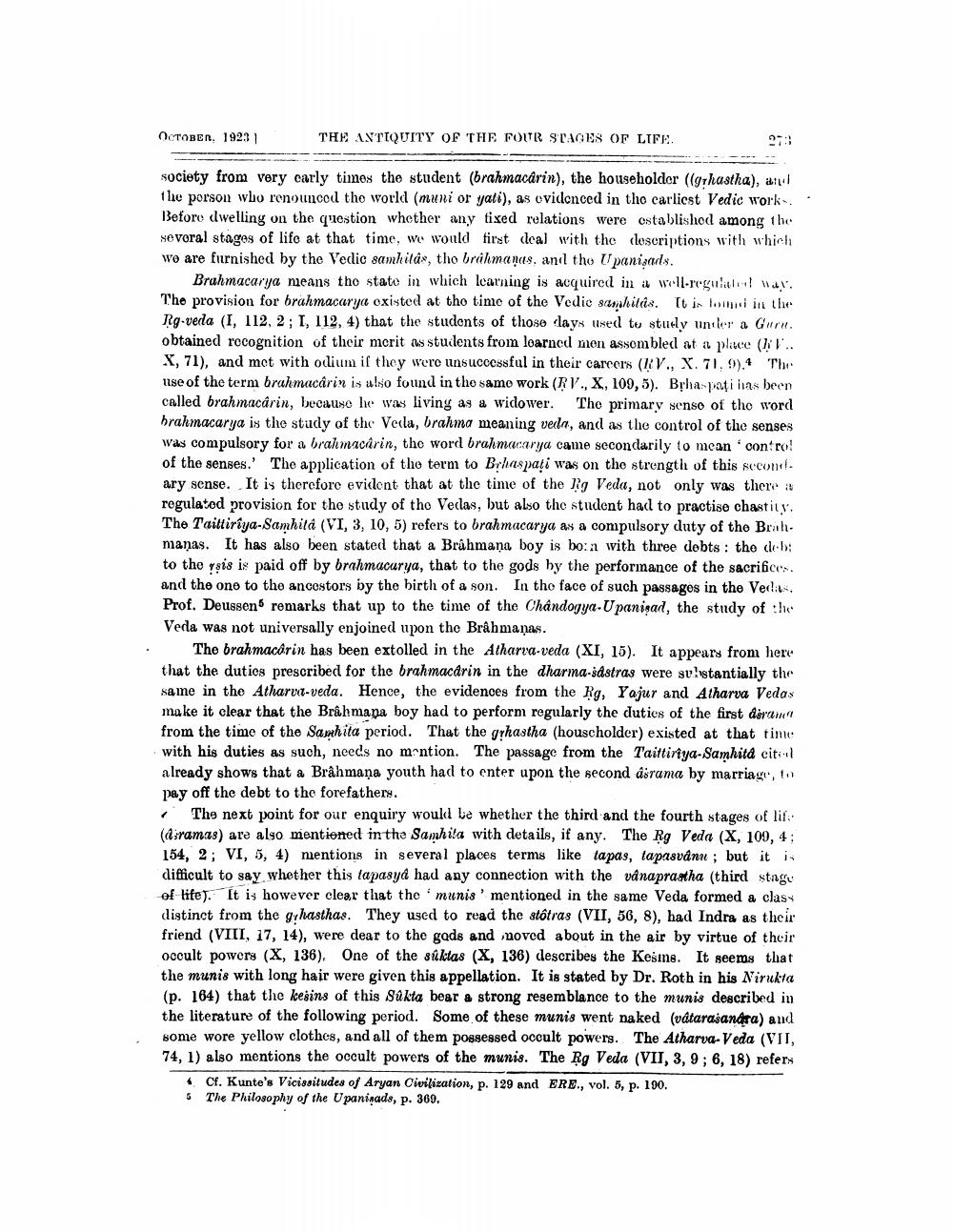________________
OCTOBER. 19231
THE ANTIQUITY OF THE FOUR STAGES OF LIFE.
27:1
society from very carly times the student (brahmacárin), the householder ((grhastha), 147 the porson who renounced the world (muni or yati), as ovidenced in the carlicst Vedic work. Beforo dwelling on the question whether any tixed relations were ostablishod among the sovoral stages of life at that time, we would first cleal with the closcriptions with which wo are furnished by the Vedic samhilds, tho brahmanas, anil tho Upanišads.
Brahmacarya means tho stato in which learning is acquired in it well-reguler! WN. The provision for brahmacaryat oxisted at tho time of the Vedio samhitas. It is loint in the Rg-veda (I, 112, 2; 1, 112, 4) that the students of those days used to study unler a Guru. obtained recognition of their merit as students from loarned mon assombled at a place (kl.. X, 71), and met with odium if they were unsuccessful in their carcers (RV., X. 71, 9). The use of the term brahmacarin is also found in the same work (RV., X, 109,5). Byhapati has been called brahmacârin, because he was living as a widower. The primary senso of the word brahmacarya is the study of the Vela, brahma meaning vedln, and as the control of the senses Wis compulsory for a brahmacárin, the word brahmacarya came secondarily to mean contro! of the senses. The application of the term to Brhaspati was on the strength of this second. ary sense. It is therefore evident that at the time of the Rig Veda, not only was there is regulatod provision for the study of the Vedas, but also the student had to practise chastity. The Taittiriya-Samhita (VI, 3, 10, 5) refers to brahmacarya as a compulsory duty of the Brahmanas. It has also been stated that a Brahmana boy is born with three debts: the deb: to the ysis is paid off by brahmaourya, that to the gods by the performance of the sacrifices. and the one to the ancestors by the birth of a son. In the face of such passages in the Vedas Prof. Deussen remarks that up to the time of the Chandogya Upanigad, the study of the Veda was not universally enjoined upon the Brahmanas.
The brahmacârin has been extolled in the Atharva-veda (XI, 15). It appears from here that the duties prescribed for the brahmacárin in the dharma-sdstras were sustantially the same in the Atharvit-veda. Hence, the evidences from the Rg. Yajur and Atharva Vedas make it clear that the Brahmana boy had to perform regularly the duties of the first deran from the time of the Samhita period. That the grhastha (houscholder) existed at that time with his duties as such, needs no mention. The passage from the Taittiriya-Samhita cita already shows that a Brâhmana youth had to enter upon the second asrama by marriage, to pay off the debt to the forefathers.
The next point for our enquiry would be whether the third and the fourth stages of lif: (diramas) are also mentioned in the Samhita with details, if any. The Rg Veda (X, 109, 4; 154, 2; VI, 5, 4) mentions in several places terms like lapas, tapasvanu ; but it is difficult to say, whether this tapasya had any connection with the vanaprastha (third stngu of life. It is however clear that the munis ' mentioned in the same Veda formed a class distinct from the grhasthas. They used to read the stôtras (VII, 56, 8), had Indra as their friend (VIII, 17, 14), were dear to the gods and moved about in the air by virtue of their occult powers (X, 136). One of the siktas (X, 136) describes the Kesins. It seems that the munis with long hair were given this appellation. It is stated by Dr. Roth in his Nirukia (p. 164) that the kesins of this Sakta bear a strong resemblance to the munis described in the literature of the following period. Some of these munis went naked (vátarasandra) and some wore yellow clothes, and all of them possessed occult powers. The Atharva-Veda (VIT, 74, 1) also mentions the occult powers of the munis. The Rg Veda (VII, 3,9; 6, 18) refers
Cf. Kunte's Vicissitudes of Aryan Civilization, p. 129 and ERE., vol. 5, p. 190. 5 The Philosophy of the Upanigads, p. 369.




